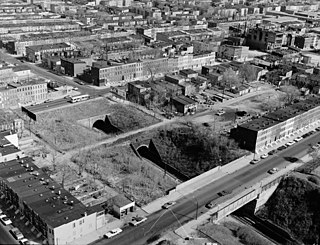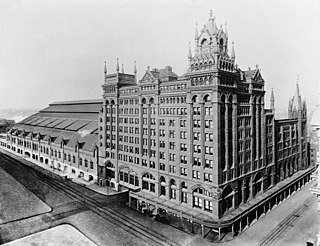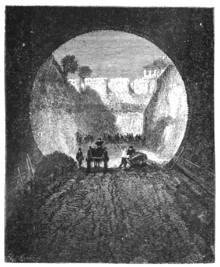
The Baltimore and Ohio Railroad was the first common carrier railroad and the oldest railroad in the United States with its first section opening in 1830. Merchants from Baltimore, which had benefited to some extent from the construction of the National Road early in the century, wanted to do business with settlers crossing the Appalachian Mountains. The railroad faced competition from several existing and proposed enterprises, including the Albany-Schenectady Turnpike, built in 1797, the Erie Canal, which opened in 1825, and the Chesapeake and Ohio Canal. At first, the B&O was located entirely in the state of Maryland; its original line extending from the port of Baltimore west to Sandy Hook, Maryland, opened in 1834. There it connected with Harper's Ferry, first by boat, then by the Wager Bridge, across the Potomac River into Virginia, and also with the navigable Shenandoah River.
The Pennsylvania Railroad, legal name The Pennsylvania Railroad Company also known as the "Pennsy", was an American Class I railroad that was established in 1846 and headquartered in Philadelphia, Pennsylvania. It was named for the commonwealth in which it was established. At its peak in 1882, the Pennsylvania Railroad was the largest railroad, the largest transportation enterprise, and the largest corporation in the world.

The Northeast Corridor (NEC) is an electrified railroad line in the Northeast megalopolis of the United States. Owned primarily by Amtrak, it runs from Boston through Providence, New Haven, Bridgeport, Stamford, New York City, Trenton, Philadelphia, Wilmington and Baltimore to Washington, D.C. The NEC closely parallels Interstate 95 for most of its length, and is the busiest passenger rail line in the United States both by ridership and by service frequency as of 2013. The NEC carries more than 2,200 trains daily.

Baltimore Penn Station, formally named Baltimore Pennsylvania Station in full, is the main inter-city passenger rail hub in Baltimore, Maryland. Designed by New York architect Kenneth MacKenzie Murchison (1872–1938), it was constructed in 1911 in the Beaux-Arts style of architecture for the Pennsylvania Railroad. It is located at 1515 N. Charles Street, about a mile and a half north of downtown and the Inner Harbor, between the Mount Vernon neighborhood to the south, and Station North to the north. Originally called Union Station because it served the Pennsylvania Railroad and Western Maryland Railway, it was renamed to match other Pennsylvania Stations in 1928.

The Center City Commuter Connection (CCCC), commonly referred to as "the commuter tunnel", is a passenger railroad tunnel in Center City, Philadelphia, Pennsylvania, United States, built to connect the stub ends of the two separate regional commuter rail systems, originally operated by two rival railroad companies: the Pennsylvania Railroad and the Reading Company. All of the SEPTA Regional Rail lines except for the Cynwyd Line pass completely through the four-track tunnel, which contains two underground stations, Suburban Station and Jefferson Station, and the above-ground upper-level concourse for the east–west commuter lines serving 30th Street Station.

The Baltimore and Potomac Railroad (B&P) operated from Baltimore, Maryland, southwest to Washington, D.C., from 1872 to 1902. Controlled by the Pennsylvania Railroad, it was the second railroad company to connect the nation's capital to the Northeastern States, and competed with the older Baltimore & Ohio Railroad.

The Philadelphia, Wilmington and Baltimore Railroad (PW&B) was an American railroad that operated independently from 1836 to 1881.
The Baltimore and Philadelphia Railroad was a railroad line built by the Baltimore and Ohio Railroad (B&O) from Philadelphia, Pennsylvania, to the Maryland-Delaware state line, where it connected with the B&O's Philadelphia Branch to reach Baltimore, Maryland. It was built in the 1880s after the B&O lost access to its previous route to Philadelphia, the Philadelphia, Wilmington and Baltimore Railroad (PW&B). The cost of building the new route, especially the Howard Street Tunnel on the connecting Baltimore Belt Line, led to the B&O's first bankruptcy. Today, the line is used by CSX Transportation for freight trains.

West Baltimore station is a regional rail station located in the western part of the City of Baltimore, Maryland along the Northeast Corridor. It is served by MARC Penn Line trains. The station is positioned on an elevated grade above and between the nearby parallel West Mulberry and West Franklin Streets at 400 North Smallwood Street. Three large surface lots are available for commuters. The station is not accessible, with two low-level side platforms next to the outer tracks, but MTA Maryland plans to later renovate the station with accessible platforms and entrances.

The Northern Central Railway (NCRY) was a Class I Railroad connecting Baltimore, Maryland with Sunbury, Pennsylvania, along the Susquehanna River. Completed in 1858, the line came under the control of the Pennsylvania Railroad (PRR) in 1861, when the PRR acquired a controlling interest in the Northern Central's stock to compete with the rival Baltimore and Ohio Railroad (B&O). For eleven decades the Northern Central operated as a subsidiary of the PRR until much of its Maryland trackage was washed out by Hurricane Agnes in 1972, after which most of its operations ceased as the Penn Central declined to repair sections. It is now a fallen flag railway, having come under the control of the later Penn Central, Conrail, and then broken apart and disestablished. The northern part in Pennsylvania is now the York County Heritage Rail Trail which connects to a similar hike/bike trail in Northern Maryland down to Baltimore, named the Torrey C. Brown Rail Trail. Trackage around Baltimore remains in rail service as well as most of the trackage in Pennsylvania which is operated by Norfolk Southern and the southernmost section in Pennsylvania is operated by the Northern Central heritage railway.
Railroad electrification in the United States began at the turn of the 20th century and comprised many different systems in many different geographical areas, few of which were connected. Despite this situation, these systems shared a small number of common reasons for electrification.

The Baltimore Belt Line was constructed by the Baltimore and Ohio Railroad (B&O) in the early 1890s to connect the railroad's newly constructed line to Philadelphia and New York City/Jersey City with the rest of the railroad at Baltimore, Maryland. It included the Howard Street Tunnel, the Mount Royal Station for B&O's Royal Blue Line passenger trains, and the first mainline railroad electrification in the United States. The line is currently operated by CSX Transportation as part of its Baltimore Terminal Subdivision.

The President Street Station in Baltimore, Maryland, is a former train station and railroad terminal. Built in 1849 and opened in February 1850, the station saw some of the earliest bloodshed of the American Civil War (1861-1865), and was an important rail link during the conflict. Today, it is the oldest surviving big-city railroad terminal in the United States. A preservation campaign and renovation project completed in 1997 enabled the station to be operated as the Baltimore Civil War Museum for several years.

Camden Station, now also referred to as Camden Street Station, Camden Yards, and formally as the Transportation Center at Camden Yards, is a train station at the intersection of South Howard and West Camden Streets in Baltimore, Maryland, and is adjacent to Oriole Park at Camden Yards, behind the B&O Warehouse. It is served by MARC commuter rail service and local Light Rail trains. Camden Street Station was originally built beginning in 1856, continuing until 1865, by the Baltimore and Ohio Railroad as its main passenger terminal and early offices/ headquarters in Baltimore and is one of the longest continuously-operated terminals in the United States. Its upstairs offices were the workplace of famous Civil War era B&O President John Work Garrett (1820–1884). The station and its environs were also the site of several infamous civil strife actions of the 19th century with the Baltimore riot of 1861, on April 18–19, also known as the Pratt Street Riots and later labor strife in the Great Railroad Strike of 1877.

The Royal Blue was the Baltimore and Ohio Railroad (B&O)'s flagship passenger train between New York City and Washington, D.C., in the United States, beginning in 1890. The Baltimore-based B&O also used the name between 1890 and 1917 for its improved passenger service between New York and Washington, collectively dubbed the Royal Blue Line. Using variants such as the Royal Limited and Royal Special for individual Royal Blue trains, the B&O operated the service in partnership with the Reading Railroad and the Central Railroad of New Jersey. Principal intermediate cities served were Philadelphia, Wilmington, and Baltimore. Later, as Europe reeled from the carnage of World War I and connotations of European royalty fell into disfavor, the B&O discreetly omitted the sobriquet Royal Blue Line from its New York passenger service and the Royal Blue disappeared from B&O timetables. Beginning in 1917, former Royal Blue Line trains were renamed: the Royal Limited, for example, became the National Limited, continuing west from Washington to St. Louis via Cincinnati. During the Depression, the B&O hearkened back to the halcyon pre-World War I era when it launched a re-christened Royal Blue train between New York and Washington in 1935. The B&O finally discontinued all passenger service north of Baltimore on April 26, 1958, including the Royal Blue.

The Baltimore and Potomac Tunnel is a double-tracked, masonry arch railroad tunnel on the Northeast Corridor in Baltimore, Maryland, just south of Pennsylvania Station. Opened in 1873, the tunnel is used by about 140 Amtrak and MARC passenger trains and two freight trains every day, as of 2008.

The Jones Falls is a 17.9-mile-long (28.8 km) stream in Maryland. It is impounded to create Lake Roland before running through the city of Baltimore and finally emptying into the Baltimore Inner Harbor.

Amtrak's 25 Hz traction power system is a traction power grid operated by Amtrak along the southern portion of its Northeast Corridor (NEC): the 226.6 route miles (362 km) between Washington, D.C. and New York City and the 104 route miles (167 km) between Philadelphia and Harrisburg, Pennsylvania. The Pennsylvania Railroad constructed it between 1915 and 1938. Amtrak inherited the system from Penn Central, the successor to the Pennsylvania Railroad, in 1976, along with the Northeast Corridor. This is the reason for using 25 Hz, as opposed to 60 Hz, which is the standard for power transmission in North America. In addition to serving the NEC, the system provides power to NJ Transit Rail Operations (NJT), the Southeastern Pennsylvania Transportation Authority (SEPTA) and the Maryland Area Regional Commuter Train (MARC). Only about half of the system's electrical capacity is used by Amtrak. The remainder is sold to the commuter railroads who operate their trains along the corridor.
The RF&P Subdivision is a railroad line operated by CSX Transportation and jointly owned by CSX and Virginia. It runs from Washington, D.C., to Richmond, Virginia, over lines previously owned by the Pennsylvania Railroad and the Richmond, Fredericksburg and Potomac Railroad. The line's name pays homage to that railroad, which was a predecessor to the CSX.

The Philadelphia, Baltimore and Washington Railroad (PB&W) was a railroad that operated in Pennsylvania, Delaware, Maryland, and the District of Columbia in the 20th century, and was a key component of the Pennsylvania Railroad (PRR) system. Its 131-mile (211 km) main line ran between Philadelphia and Washington. The PB&W main line is now part of the Northeast Corridor, owned by Amtrak.
















